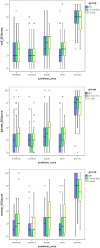Mental health problems in adolescents with cochlear implants: peer problems persist after controlling for additional handicaps
- PMID: 26236251
- PMCID: PMC4502340
- DOI: 10.3389/fpsyg.2015.00953
Mental health problems in adolescents with cochlear implants: peer problems persist after controlling for additional handicaps
Abstract
The aims of the present multi-center study were to investigate the extent of mental health problems in adolescents with a hearing loss and cochlear implants (CIs) in comparison to normal hearing (NH) peers and to investigate possible relations between the extent of mental health problems of young CI users and hearing variables, such as age at implantation, or functional gain of CI. The survey included 140 adolescents with CI (mean age = 14.7, SD = 1.5 years) and 140 NH adolescents (mean age = 14.8, SD = 1.4 years), their parents and teachers. Participants were matched by age, gender and social background. Within the CI group, 35 adolescents were identified as "risk cases" due to possible and manifest additional handicaps, and 11 adolescents were non-classifiable. Mental health problems were assessed with the Strengths and Difficulties Questionnaire (SDQ) in the versions "Self," "Parent," and "Teacher." The CI group showed significantly more "Peer Problems" than the NH group. When the CI group was split into a "risk-group" (35 "risk cases" and 11 non-classifiable persons) and a "non-risk group" (n = 94), increased peer problems were perceived in both CI subgroups by adolescents themselves. However, no further differences between the CI non-risk group and the NH group were observed in any rater. The CI risk-group showed significantly more hyperactivity compared to the NH group and more hyperactivity and conduct problems compared to the CI non-risk group. Cluster analyses confirmed that there were significantly more adolescents with high problems in the CI risk-group compared to the CI non-risk group and the NH group. Adolescents with CI, who were able to understand speech in noise had significantly less difficulties compared to constricted CI users. Parents, teachers, and clinicians should be aware that CI users with additionally special needs may have mental health problems. However, peer problems were also experienced by CI adolescents without additional handicaps.
Keywords: SDQ; adolescents; cochlear implants; hearing loss; mental health problems; multi handicap; multi-center study; peer problems.
Figures

Similar articles
-
Schooling Relates to Mental Health Problems in Adolescents with Cochlear Implants-Mediation by Hearing and Family Variables.Front Psychol. 2015 Dec 18;6:1889. doi: 10.3389/fpsyg.2015.01889. eCollection 2015. Front Psychol. 2015. PMID: 26733898 Free PMC article.
-
The mental health of deaf adolescents with cochlear implants compared to their hearing peers.Int J Audiol. 2011 Mar;50(3):146-54. doi: 10.3109/14992027.2010.533704. Epub 2011 Feb 10. Int J Audiol. 2011. PMID: 21309643
-
List equivalency of the AzBio sentence test in noise for listeners with normal-hearing sensitivity or cochlear implants.J Am Acad Audiol. 2012 Jul-Aug;23(7):501-9. doi: 10.3766/jaaa.23.7.2. J Am Acad Audiol. 2012. PMID: 22992257 Clinical Trial.
-
Using Microphone Technology to Improve Speech Perception in Noise in Children with Cochlear Implants.J Am Acad Audiol. 2018 Oct;29(9):814-825. doi: 10.3766/jaaa.17035. J Am Acad Audiol. 2018. PMID: 30278866
-
Social participation of children and adolescents with cochlear implants: a qualitative analysis of parent, teacher, and child interviews.J Deaf Stud Deaf Educ. 2011 Fall;16(4):474-93. doi: 10.1093/deafed/enr001. Epub 2011 Mar 3. J Deaf Stud Deaf Educ. 2011. PMID: 21372111 Review.
Cited by
-
Self-esteem in the deaf who have become cochlear implant users as adults.PLoS One. 2018 Sep 11;13(9):e0203680. doi: 10.1371/journal.pone.0203680. eCollection 2018. PLoS One. 2018. PMID: 30204775 Free PMC article.
-
Wellbeing as Capability: Findings in Hearing-Impaired Adolescents and Young Adults With a Hearing Aid or Cochlear Implant.Front Psychol. 2022 Jun 23;13:895868. doi: 10.3389/fpsyg.2022.895868. eCollection 2022. Front Psychol. 2022. PMID: 35814130 Free PMC article.
-
Cochlear implant-specific risks should be considered, when assessing the quality of life of children and adolescents with hearing loss and cochlear implants-not just cochlear implant-specific benefits-Perspective.Front Neurosci. 2022 Nov 8;16:985230. doi: 10.3389/fnins.2022.985230. eCollection 2022. Front Neurosci. 2022. PMID: 36425475 Free PMC article.
-
Restricted Speech Recognition in Noise and Quality of Life of Hearing-Impaired Children and Adolescents With Cochlear Implants - Need for Studies Addressing This Topic With Valid Pediatric Quality of Life Instruments.Front Psychol. 2019 Sep 12;10:2085. doi: 10.3389/fpsyg.2019.02085. eCollection 2019. Front Psychol. 2019. PMID: 31572268 Free PMC article.
-
Hearing and sociality: the implications of hearing loss on social life.Front Neurosci. 2023 Oct 3;17:1245434. doi: 10.3389/fnins.2023.1245434. eCollection 2023. Front Neurosci. 2023. PMID: 37854291 Free PMC article. Review.
References
-
- American Psychiatric Association (2013). Diagnostic and Statistical Manual of Mental Disorders, 5th Edn. Arlington, VA: American Psychiatric Publishing.
LinkOut - more resources
Full Text Sources
Other Literature Sources

